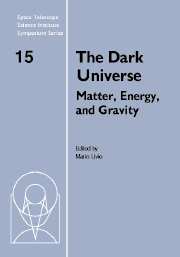Book contents
- Frontmatter
- Contents
- Participants
- Preface
- A brief history of dark matter
- Microlensing towards the Magellanic Clouds: Nature of the lenses and implications on dark matter
- Searching for the Galactic dark matter
- Hot gas in clusters of galaxies and ΩM
- Tracking the baryon density from the Big Bang to the present
- Modified Newtonian Dynamics and its implications
- Cosmological parameters and quintessence from radio galaxies
- The mass density of the Universe
- Growth of structure in the Universe
- Cosmological implications of the most distant supernova (known)
- Dynamical probes of the Halo Mass Function
- Detection of gravitational waves from inflation
- Cosmological constant problems and their solutions
- Dark matter and dark energy: A physicist's perspective
Cosmological implications of the most distant supernova (known)
Published online by Cambridge University Press: 21 August 2009
- Frontmatter
- Contents
- Participants
- Preface
- A brief history of dark matter
- Microlensing towards the Magellanic Clouds: Nature of the lenses and implications on dark matter
- Searching for the Galactic dark matter
- Hot gas in clusters of galaxies and ΩM
- Tracking the baryon density from the Big Bang to the present
- Modified Newtonian Dynamics and its implications
- Cosmological parameters and quintessence from radio galaxies
- The mass density of the Universe
- Growth of structure in the Universe
- Cosmological implications of the most distant supernova (known)
- Dynamical probes of the Halo Mass Function
- Detection of gravitational waves from inflation
- Cosmological constant problems and their solutions
- Dark matter and dark energy: A physicist's perspective
Summary
We present photometric observations of an apparent Type Ia supernova (SN Ia) at a redshift of ∼1.7, the farthest SN observed to date. The supernova, SN1997ff, was discovered in a repeat observation by the Hubble Space Telescope (HST) of the Hubble Deep Field-North (HDF-N), and serendipitously monitored with NICMOS on HST throughout the Thompson et al. GTO campaign. The SN type can be determined from the host galaxy type: an evolved, red elliptical lacking enough recent star formation to provide a significant population of core-collapse supernovae. The classification is further supported by diagnostics available from the observed colors and temporal behavior of the SN, both of which match a typical SN Ia. The photometric record of the SN includes a dozen flux measurements in the I, J, and H bands spanning 35 days in the observed frame. The redshift derived from the SN photometry, z = 1.7±0.1, is in excellent agreement with the redshift estimate of z = 1.65 ± 0.15 derived from the U300B450V606I814J110J125H160H165Ks photometry of the galaxy. Optical and near-infrared spectra of the host provide a very tentative spectroscopic redshift of 1.755. Fits to observations of the SN provide constraints for the redshift-distance relation of SNe Ia and a powerful test of the current accelerating Universe hypothesis. The apparent SN brightness is consistent with that expected in the decelerating phase of the preferred cosmological model, ΩM ≈ 1/3, ΩΛ ≈ 2/3.
- Type
- Chapter
- Information
- The Dark UniverseMatter, Energy and Gravity, pp. 123 - 138Publisher: Cambridge University PressPrint publication year: 2004

